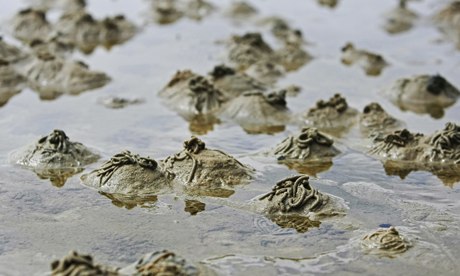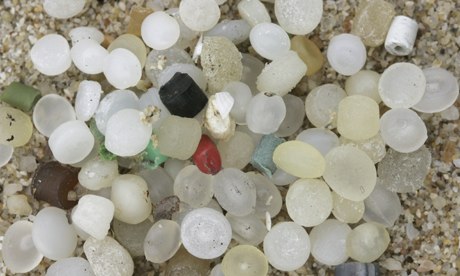published Dec. 2, 2013 in The Guardian by Jessica Aldred
Ingestion of microplastics by lugworms could have impact on ocean ecosystems due to their importance to food chain

Lugworms are widely found across the whole of the north Atlantic, living in burrows in the sand of beaches. Photograph: Alamy
Tiny bits of plastic rubbish ingested by marine worms is
significantly harming their health and will have wider impact on ocean
ecosystems, scientists have found.
Microplastic particles, measuring less than 5mm in size, have been accumulating in the oceans since the 1960s and are now the most abundant form of solid-waste pollution on Earth.
Two UK-based studies published in the journal Current Biology looked at whether these near-invisible, microscopic plastics that sink into mud and sand in high concentrations are causing harm to species at the base of the food chain that ingest this sediment during feeding, and play a key ecological role as a source of food for other animals.
Using the lugworm as an indicator species, the first study, from the University of Exeter, found that worms feeding in highly contaminated ocean sediment ate less and had lower energy levels. The second study, from Plymouth University, has established for the first time that ingesting microplastics can transfer pollutants and additives to worms, reducing health and biodiversity.
Ingestion of microplastics by species at the base of the food web is a cause for concern as little has been known about its effects until now. Many other organisms that have a similar feeding behaviour, such as starfish, sea cucumbers and fiddler crabs, may be similarly affected.
Lugworms are common invertebrates found widely found across the whole of the north Atlantic, living in burrows in the sand of beaches. They eat sand particles, digesting any micro-organisms and nutrients and passing the sand as waste through their tail, leaving a distinctive trail or "cast" on the beach. The worm can make up about 30% of the biomass of an average sandy beach, making it an important source of food for wading birds and flatfish.
The "earthworms of the sea", lugworms provide another important ecosystem service by turning over large volumes of sand, replenishing organic material and oxygenating the upper layers to keep the sediment healthy for other animals and microorganisms to thrive in.
Microplastics can be made from polyethylene, polyethylene terephthalate, PVC or polystyrene. They are too small to be captured through existing wastewater treatment process, and wash straight into the ocean.
 Pre-production plastic pellets, or 'nurdles' on the windward side of
South Sokos Island, Hong Kong. Photograph: Alex Hofford/EPA
Pre-production plastic pellets, or 'nurdles' on the windward side of
South Sokos Island, Hong Kong. Photograph: Alex Hofford/EPA
Microplastic particles, measuring less than 5mm in size, have been accumulating in the oceans since the 1960s and are now the most abundant form of solid-waste pollution on Earth.
Two UK-based studies published in the journal Current Biology looked at whether these near-invisible, microscopic plastics that sink into mud and sand in high concentrations are causing harm to species at the base of the food chain that ingest this sediment during feeding, and play a key ecological role as a source of food for other animals.
Using the lugworm as an indicator species, the first study, from the University of Exeter, found that worms feeding in highly contaminated ocean sediment ate less and had lower energy levels. The second study, from Plymouth University, has established for the first time that ingesting microplastics can transfer pollutants and additives to worms, reducing health and biodiversity.
Ingestion of microplastics by species at the base of the food web is a cause for concern as little has been known about its effects until now. Many other organisms that have a similar feeding behaviour, such as starfish, sea cucumbers and fiddler crabs, may be similarly affected.
Lugworms are common invertebrates found widely found across the whole of the north Atlantic, living in burrows in the sand of beaches. They eat sand particles, digesting any micro-organisms and nutrients and passing the sand as waste through their tail, leaving a distinctive trail or "cast" on the beach. The worm can make up about 30% of the biomass of an average sandy beach, making it an important source of food for wading birds and flatfish.
The "earthworms of the sea", lugworms provide another important ecosystem service by turning over large volumes of sand, replenishing organic material and oxygenating the upper layers to keep the sediment healthy for other animals and microorganisms to thrive in.
Microplastics can be made from polyethylene, polyethylene terephthalate, PVC or polystyrene. They are too small to be captured through existing wastewater treatment process, and wash straight into the ocean.
 Pre-production plastic pellets, or 'nurdles' on the windward side of
South Sokos Island, Hong Kong. Photograph: Alex Hofford/EPA
Pre-production plastic pellets, or 'nurdles' on the windward side of
South Sokos Island, Hong Kong. Photograph: Alex Hofford/EPA
They fall into three categories: the raw material called "nurdles"
that are melted down to make larger plastic items or used as exfoliating
beads in cosmetic products, or larger pieces of plastic that have
degraded and broken down into smaller particles over time. Microplastics
are also found as fibres and have been traced back to synthetic
textiles like polyester that are used to make clothes, which can release up to 1,900 tiny fibres per garment every time they are washed.
Microplastics carry a complex mix of chemicals which have the potential to harm the worms, the research showed. Many plastics contain chemical additives, such as plasticisers, dyes, and antimicrobials, which can leach out into sediments and seawater. Microplastics also concentrate water-borne chemicals on their surfaces, such as pesticides and detergents.
There has been much campaigning around the impact of larger marine plastic pollution, with widely documented instances of fish and bird entanglement, ingestion and suffocation. But particles of this microscopic size are available to a much broader range of marine organisms, who ingest and retain these tiny plastic particles and act as prey for larger species.
The first study, by Stephanie Wright from the University of Exeter, put worms into laboratory tanks of varying levels of plastics contamination for up to one month, measuring their growth, physiology, survival and ability to gain weight. She found that lugworms feeding in sediment that was highly contaminated with microplastics put on less weight than worms in clean sediment and had less energy to invest in key processes such as growth and reproduction. These effects could cause populations to decline with knock-on effects for predators, the paper found.
Reduced feeding also means the sediment is being reworked less, the research found. The condition of the sediment could fall, leading to a decline in the communities which live in it. Wright said: "If worms in contaminated environments were to reduce feeding levels by an amount comparable to that seen in the lab, it would mean significantly less turnover of sediment. In an area the size of the Wadden Sea, for instance, sediment turnover could drop by more than 130,000 litres each year."
"We believe our study has highlighted the need to reduce the amount of plastic waste and therefore microplastics which enter our seas," says Prof Tamara Galloway of the University of Exeter. "Plastics are enormously beneficial materials. However, if marine plastic pollution continues to increase, impacts such as those demonstrated in our laboratory studies could occur in the natural environment. It is therefore important that we prevent the accumulation of plastic and microplastic debris in marine habitats through better waste-handling practices and smarter choices in the materials we use."
A separate report, from Dr Mark Anthony Browne on work performed at Plymouth University, showed microplastics can transfer harmful chemicals to lugworms, including hydrocarbons, antimicrobials and flame retardants. Due to its role as a prey species, lugworms could pass these chemicals up the food chain to top predators such as fish.
"These chemicals are persistent, meaning they could accumulate in the tissue of organisms and take a long time to break down," said Prof Richard Thompson of the school of marine science and engineering at Plymouth University, who was the project lead for the work. "Our laboratory studies provide the first clear evidence that microplastics could cause harm and show that this could result from both the physical presence of ingested plastic and chemical transfer. Our next steps will be to establish the full implications of these findings for organisms in natural habitats."
Microplastics carry a complex mix of chemicals which have the potential to harm the worms, the research showed. Many plastics contain chemical additives, such as plasticisers, dyes, and antimicrobials, which can leach out into sediments and seawater. Microplastics also concentrate water-borne chemicals on their surfaces, such as pesticides and detergents.
There has been much campaigning around the impact of larger marine plastic pollution, with widely documented instances of fish and bird entanglement, ingestion and suffocation. But particles of this microscopic size are available to a much broader range of marine organisms, who ingest and retain these tiny plastic particles and act as prey for larger species.
The first study, by Stephanie Wright from the University of Exeter, put worms into laboratory tanks of varying levels of plastics contamination for up to one month, measuring their growth, physiology, survival and ability to gain weight. She found that lugworms feeding in sediment that was highly contaminated with microplastics put on less weight than worms in clean sediment and had less energy to invest in key processes such as growth and reproduction. These effects could cause populations to decline with knock-on effects for predators, the paper found.
Reduced feeding also means the sediment is being reworked less, the research found. The condition of the sediment could fall, leading to a decline in the communities which live in it. Wright said: "If worms in contaminated environments were to reduce feeding levels by an amount comparable to that seen in the lab, it would mean significantly less turnover of sediment. In an area the size of the Wadden Sea, for instance, sediment turnover could drop by more than 130,000 litres each year."
"We believe our study has highlighted the need to reduce the amount of plastic waste and therefore microplastics which enter our seas," says Prof Tamara Galloway of the University of Exeter. "Plastics are enormously beneficial materials. However, if marine plastic pollution continues to increase, impacts such as those demonstrated in our laboratory studies could occur in the natural environment. It is therefore important that we prevent the accumulation of plastic and microplastic debris in marine habitats through better waste-handling practices and smarter choices in the materials we use."
A separate report, from Dr Mark Anthony Browne on work performed at Plymouth University, showed microplastics can transfer harmful chemicals to lugworms, including hydrocarbons, antimicrobials and flame retardants. Due to its role as a prey species, lugworms could pass these chemicals up the food chain to top predators such as fish.
"These chemicals are persistent, meaning they could accumulate in the tissue of organisms and take a long time to break down," said Prof Richard Thompson of the school of marine science and engineering at Plymouth University, who was the project lead for the work. "Our laboratory studies provide the first clear evidence that microplastics could cause harm and show that this could result from both the physical presence of ingested plastic and chemical transfer. Our next steps will be to establish the full implications of these findings for organisms in natural habitats."
No comments:
Post a Comment
Note: Only a member of this blog may post a comment.